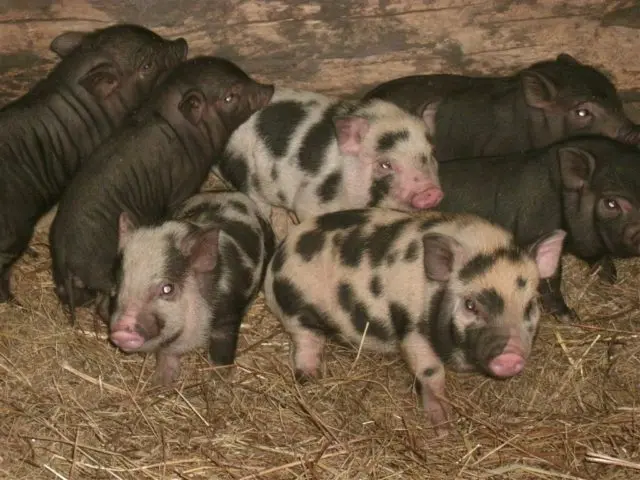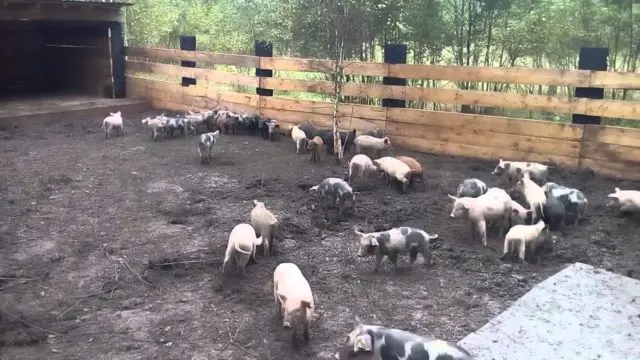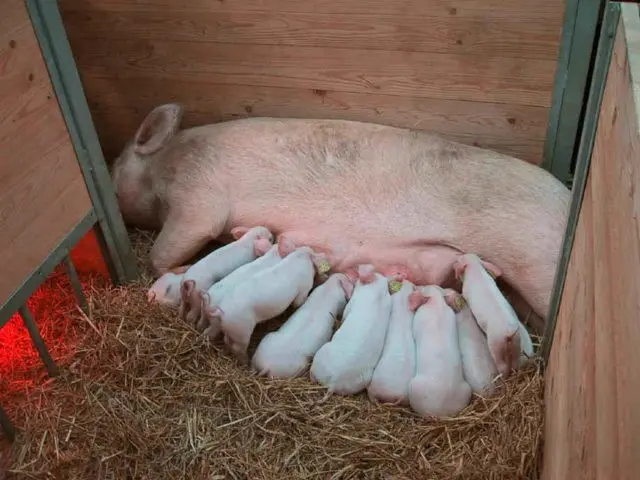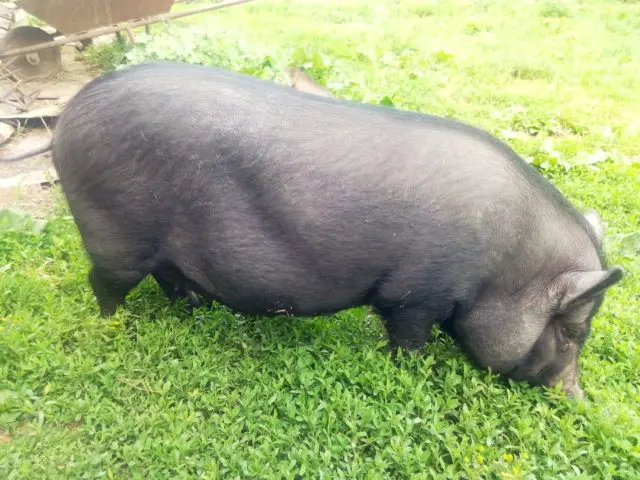Contents
Pig breeding at home is one of the ways to provide a family with environmentally friendly meat and lard at minimal cost.
Benefits of raising pigs at home
Pigs are not demanding on the conditions of detention, omnivorous, practically not prone to diseases. Having decided to raise pigs, you need to carefully consider the diet, conditions of detention, determine the breed, choose the right room for pigs. The main advantages of pig breeding are considered to be:
- low susceptibility of pigs to diseases;
- high fertility of pigs (a sow can bring 2 offspring of 10-14 piglets per year);
- one pig is able to give a large yield of meat and fat;
- pork is in great demand in the food market;
- fast growth, high productivity of pigs (the weight of a newborn piglet is 10 kg, by half a year it reaches 100 kg).
Pigs and piglets are unpretentious, but this does not mean that they will not require care at all.
Breed selection
It is impossible to determine which pig breed is the best for raising piglets at home, since any one can adapt to nutrition and maintenance. It is necessary to figure out which direction of productivity this or that breed of pigs belongs to. There are 3 main types of productivity:
- greasy type of pigs;
- meat (bacon) type of pigs;
- universal type of pigs.
Greasy breeds of pigs are distinguished by a massive front part. The growth of muscle tissue slows down somewhat by six months, and adipose tissue continues to grow actively. The amount of meat on the carcasses of such pigs reaches only 50%. Popular breeds of pigs of greasy type: Ukrainian, Large black, Berkshire pig.
The muscle mass of meat or bacon breeds of pigs grows very quickly, fat lags behind in development. With the right diet, by the age of 7 months, the weight of a pig can be 100 kg. The amount of meat from the carcass of one animal is from 60 to 70% of the total mass. Representatives of the meat type of pigs: Landrace, Estonian bacon, English large white pig.
Representatives of the universal (meat) type of pigs give a large amount of meat before reaching adulthood. Pigs gain weight well even with standard fattening. Breeds: North Caucasian, Murom, Breit pig.

What to look for when buying piglets
Beginning pig breeders who plan to raise pigs at home need to know that the best age to buy a piglet is 2,5 months. By this period, they are weaned from their mother, taught to eat on their own. It is worth observing how babies behave during feeding. Healthy animals greedily pounce on food, actively eat adult food. In appearance, they should be mobile, strong, with clean skin, eyes, hair.
It is also necessary to pay attention to the parents in order to understand what to expect in the future from the individual. A sow, for example, should be quite prolific, have high milk production.
Preparing the piglet rearing area
Growing piglets at home requires the construction or conversion of a room for a pigsty. It is desirable that it be located no closer than 10 m from a residential building. It is worth allocating a platform for walking or stall-walking piglets.
Requirements for the premises for raising pigs:
- room temperature 10-20 °C;
- heating system;
- good ventilation;
- windows for ventilation and light;
- the height of the room is not less than 2,5 m;
- a boardwalk floor with a slight slope;
- for ceilings, walls, it is better to use lime as a disinfectant.
The area for walking pigs and piglets should be with a canopy from the sun and rain, as well as protection from the wind.
Ways of keeping pigs
Successful breeding of pigs at home largely depends on the way the animals are kept. The most common ones are:
- cellular method of keeping pigs;
- walkless;
- walking
The cell method of raising pigs is used by large pig farms. Each of the cells contains about 3 individuals, there is a small angle of inclination, with the help of which excrement, liquid food residues flow into a special channel. The microclimate on such farms is regulated by automated systems.
Walk-free keeping of pigs is also used in large farms, as it is the most cost-effective. But this method negatively affects the physical condition of pets. So that the livestock does not have health problems, it is necessary to pay attention to feeding and caring for pigs.
For breeding piglets by novice farmers at home, the walking method of growing is best suited. Animals, being in open areas, actively move, receive the necessary amount of air and light. Such sites should be equipped with sunshades, drinkers and feeders. This rearing method is not suitable for suckling pigs and newborn piglets.

Requirements for a pigsty
The premises for pigs should be bright, warm, with good ventilation. Only farrowing sows with newborns are best kept separately. In large farms, fixing machines are organized for farrowing and the subsequent maintenance of a pig with offspring. In the summer, it is necessary to moisten part of the floor in the machines. Humidity should be 70%, more than 85% is already dangerous for newborn piglets. If it is assumed that there are several machines, then the minimum passage between them must be made about 1,5 m.
The area per pig should be up to 5 sq.m. The norm of the area for walking (per 1 head sq.m.) of sows is 5 sq.m., heavily pregnant (one week before farrowing) and suckling queens with offspring – 10 sq.m.
How to raise a pig
Young animals go through several stages of development:
- period of breastfeeding;
- separation from the mother;
- fattening

Caring for piglets at home is quite simple, but it is necessary to take into account their features at each stage. For dairy piglets, a separate place in the machine is equipped with about 1,5 square meters. m. The recommended room temperature is not lower than 15 ° C, since piglets are not yet able to regulate body temperature on their own. Up to 25 days of age, newborn piglets feed only on mother’s milk. On day 3, they are given an iron-based injection to prevent anemia.
Weakened babies are placed in a warm machine, soldered with milk with concentrates, then they begin to replace them with roughage.
Weaning is carried out from the age of one month, when the weight of the individual reaches 17 kg. This happens gradually over 4 days:
- 1 day – contact with the mother about 6 times a day;
- 2 day – 4 times;
- 3 day – 2 times;
- Day 4 – 1 time.
Increase the diet 7 days after the absence.
Care for newborn piglets
Piglets are considered newborn from the moment of birth to the separation of the stump of the umbilical cord. This period is the most dangerous, since the basic functions of the body are still unstable. Therefore, when caring for newborn piglets at home, it is necessary to carefully monitor the needs of the babies at this stage.
From 4 days after weaning, young animals are taught to eat chalk, charcoal, roasted grains, red clay. Water should be changed twice a day, drinkers must be washed before changing water.
Often, for the first time, a pig that is farrowing does not produce milk. In this case, the piglets are transferred to artificial feeding, using ready-made mixtures prepared on their own. To 1 liter of cow’s milk add 30 ml of boiled water, homemade chicken egg, 1 tsp. sugar, vitamins A and D (1 ml each), ferrous sulfate 1% – 10 g, aminopeptide 2,5 g.
Pigs accustomed to feeding from an early age are more active, better massage the mammary glands of the pig, thereby improving milk flow. The first feeding is given from 4 days. This is cow’s milk, reverse, acidophilus milk. From the 5th day they are given porridge made from barley, oatmeal or wheat groats, cooked on the back.
Walks start from 3 days of life in summer, in winter from 5-7 days, starting from 10 minutes. The air strengthens the body, the sun allows you to accumulate vitamin D.
Raising weaned piglets
Weaned mice are very sensitive to gastrointestinal infections, so they are fed 5 times a day at regular intervals. The result of the correct feeding technology should be a daily weight gain – 400 g. The diet usually contains fish, bone meal, clover, alfalfa, necessarily milk skid. Boiled vegetables should also be present; in the summer, legumes are fed to piglets along with tops.
Up to 3 months, dry food is steamed with hot water so as not to injure the gastric mucosa.
With early weaning, you should feed about 15 times a day at regular intervals with boiled cow’s milk. Complementary foods are introduced in the same way as for piglets at a later weaning.
How to raise piglets for meat
When raising pigs for meat until they reach 70 kg (while muscle mass is growing), the diet should consist of protein-rich feed: peas, legumes, skim milk, fishmeal. After the diet should be enriched with cereals, succulent feed.
With bacon fattening (a kind of meat), the diet consists of barley, vetch, legumes, and various additives of animal origin.
Many pig farmers use a simplified fattening system when raising pigs, choosing one of the options – dry or wet. In the wet version, piglets are fed with mashes (boiled potatoes, food waste, herbs), crushed grain, cake, pea flour are added. The dry version is more expensive. It is common for piglets to become constipated (especially if they are not drinking enough water). But this method is the most effective and simple.
How to raise pigs
Pigs belong to the family of non-ruminant artiodactyls. In the society of their relatives, they absorb food much more actively. Thus, when group rearing animals at home, they gain weight faster. When forming groups, it is necessary to take into account the age, sex, live weight, physiological state of the pigs.
It must be taken into account that temperature changes, high humidity, noise, vaccination, and transportation adversely affect pigs.
Breeding pigs at home for beginners should be based on knowledge of the behavioral and physiological characteristics of animals.

Raising pigs for meat
With proper fattening, a pig at 7 months should weigh about 100 kg, of which 70% of the useful weight. If the goal is to raise pigs for meat at home, then you need to choose from two main types of fattening: intensive and low-intensity.
With intensive fattening of pigs, you can get meat in the shortest possible time. To do this, it is better to purchase purebred four-month-old pigs weighing about 30 kg. With proper nutrition of the pig with combined feed, legumes, the daily weight gain will be 650 g. The output is juicy meat with a thin layer of fat.
With low-intensity fattening, the pig grows more slowly, reaches 100 kg in a longer amount of time. The essence of fattening is that the pig eats more, but inexpensive feed.
Features of keeping sows
The content of the sow depends on her physiological state. If we talk about the period of preparing a pig for pregnancy and bearing healthy offspring, then you need to create all the conditions for successful fertilization.
Before mating, pigs are kept in small groups. In the warm season, it is necessary to equip a walking area to keep the sows in good shape and prevent obesity. Females in the hunt are settled in separate pens until pregnancy is determined.
But the main thing is a special feeding regimen. It should be varied (include all types of feed) and balanced. The issuance is carried out 2 times a day and the amount of food eaten is controlled. If food remains in the feeder, then during subsequent feeding, the amount of food is reduced.
Raising pigs using Canadian technology
The main thing that is necessary for breeding pigs at home using Canadian technology is a hangar with a transparent roof and large rolls of straw.
Technology advantages:
- there are no costs for heating, lighting, since a thick layer of straw (20 cm) and moisture will maintain the temperature up to +15 ° C, in addition, pigs will be able to burrow into the straw;
- increasing the immunity of pigs due to greater mobility, light, environmentally friendly straw;
- rapid building of the premises.
When cleaning, you need to remove only the top layer. The straw is completely removed twice a year – in spring and autumn.
Cons of keeping: an unpleasant smell, high humidity, early weaning of piglets from a pig, which is stressful for them.
Conclusion
Pig breeding at home is a fairly profitable and uncomplicated activity that a novice farmer can master with the right organization and a competent approach. The success of breeding largely depends on the creation of good living conditions, a balanced diet for pigs. Much depends on the personal qualities of a person, his hard work, ability to work with animals.
It is necessary to take into account the disadvantages of raising pigs: the difficulty in caring for pigs, the laboriousness of the process, the risks (animals can get sick, and this will lead to mass death), certain means. The main requirement: an extremely serious attitude to all stages of raising pigs.









